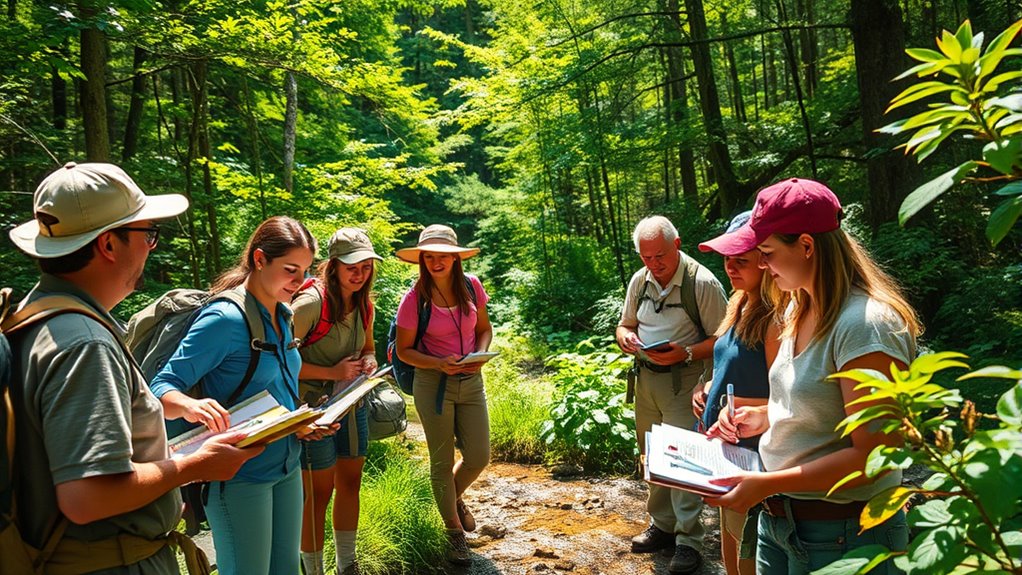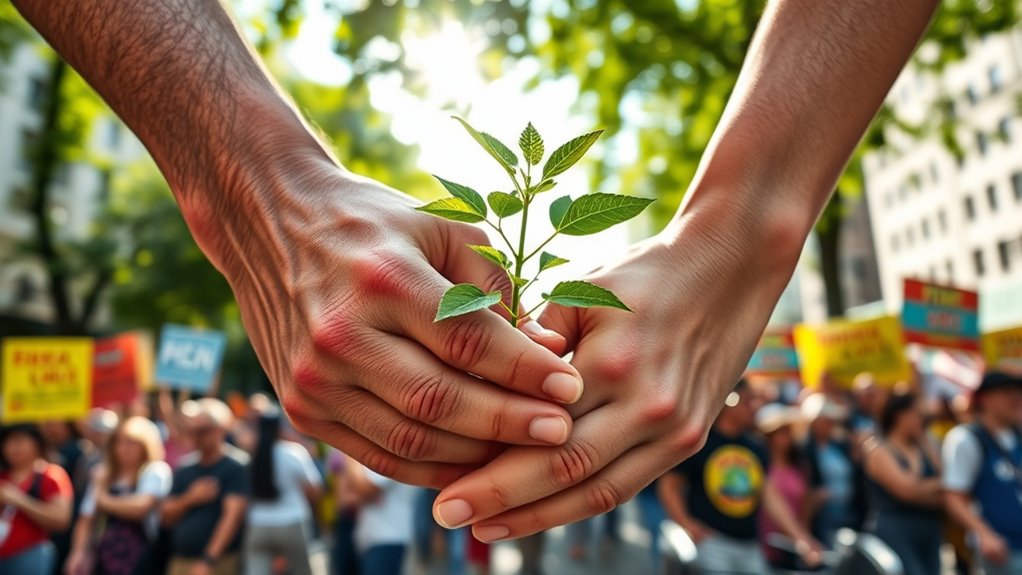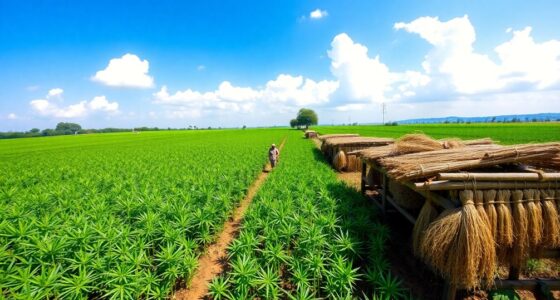You can get involved in conservation in several impactful ways. Start by volunteering for local projects, like beach cleanups or community gardens. Support conservation organizations through donations or fundraising. Participate in community events, such as park cleanups or wetland restoration. Engage in research by contributing to citizen science projects. Finally, advocate for conservation policies by connecting with decision-makers and raising awareness. There’s so much more you can do to help preserve our planet’s biodiversity.
Key Takeaways
- Volunteer for local research projects on wildlife populations, such as American eels or amphibians, to contribute to conservation efforts.
- Support conservation organizations through financial contributions or recurring donations to fund impactful projects and initiatives.
- Participate in community events like beach cleanups, park maintenance, or urban gardening to promote environmental stewardship.
- Engage in citizen science projects or surveys to help collect valuable data for conservation research and biodiversity preservation.
- Advocate for conservation policies by raising awareness, building relationships with decision-makers, and utilizing social media to amplify your message.
Volunteering Opportunities

When you get involved in conservation, volunteering opportunities abound across various programs and initiatives. You can contribute to critical research like studying the American eel population or monitoring amphibian migrations. Engaging in such research can help you understand the importance of ecosystem health and its impact on biodiversity. Additionally, participating in conservation efforts may improve your emotional well-being, similar to the benefits seen in pet therapy for dementia patients. Furthermore, many conservation projects often rely on community involvement to achieve their goals and enhance local ecosystems.
If you’re a fishing enthusiast, consider joining the Anglers Diary Cooperator Program to collect valuable data on fishing practices. You might also assist in maintaining artificial reefs or contribute to the Hudson River Striped Bass Program.
Environmental education centers offer roles as instructors or maintenance helpers in places like Delmar or Wappingers Falls. For community efforts, you could participate in beach cleanups through the Adopt-A-Beach Program or help with forest management. Ensuring financial transparency within these organizations allows you to understand how your efforts support meaningful conservation work.
These hands-on experiences allow you to make a tangible impact on local ecosystems.
Support Conservation Organizations

Supporting conservation organizations is essential for safeguarding our planet’s natural resources. Your financial contributions play a crucial role in funding vital research and conservation projects. Many organizations offer flexible donation options, allowing you to support specific programs that resonate with you. Even modest donations can collectively create a significant impact. Direct involvement in conservation missions through hands-on field activities can also enhance your engagement and understanding of the challenges faced by endangered species. Engaging in community events can further strengthen the network of support for conservation efforts and foster connections among like-minded individuals. It’s also wise to research organizations to ensure they’ve a strong track record and financial transparency. Consider setting up recurring donations for continuous support. Additionally, supporting these organizations can help foster biodiversity conservation, which is crucial for maintaining ecosystem balance. Conservation organizations often focus on biodiversity hotspots, areas where unique species are at risk, to maximize their impact. Beyond financial aid, participating in educational initiatives helps raise awareness and shapes public opinion.
Participate in Community Events

Engaging in community events is a rewarding way to contribute to conservation efforts while connecting with others who share your passion for the environment. You can participate in community gardens that promote agriculture and environmental education, or help with urban greenways that enhance recreation and wildlife viewing. Join wetland restoration projects to boost biodiversity and create more recreational opportunities, which align with the goals of eco-friendly excursions. Additionally, participating in sustainable initiatives can amplify the impact of your efforts and inspire others to join. Take part in park cleanups to keep local parks pristine, or support litter reduction campaigns to raise awareness about waste management. Engaging in these activities not only fosters a deeper connection between people and nature but also promotes mindfulness and encourages a more sustainable lifestyle. Get involved in wildlife viewing initiatives that protect natural habitats, or attend education programs that inform you about local ecosystems. These activities often address local community needs and foster a deeper connection between people and nature.
Engage in Research Participation

Participating in research can significantly enhance your understanding of conservation issues while empowering local communities. Engaging in participatory research means you’ll collaborate with indigenous peoples, fostering trust and mutual understanding. This approach recognizes their vital role in conservation, as highlighted in the Kunming-Montreal Global Biodiversity Framework. Additionally, advancements in biodegradable materials are crucial for reducing plastic waste, which directly impacts conservation efforts. Moreover, utilizing AI-driven data analytics can enhance the effectiveness of conservation strategies by providing insights into ecosystem dynamics.
You can utilize various methods, like surveys and citizen science projects, to collect data and enhance community awareness. By integrating traditional knowledge with scientific research, you’ll promote equity and inclusivity, leading to better conservation outcomes. Additionally, it’s essential to recognize that participatory research facilitates a paradigm shift towards equitable and inclusive conservation practices. Understanding the importance of biodiversity preservation is critical for effective conservation strategies.
While challenges like ethical considerations and logistics exist, the benefits outweigh them. Your active involvement not only supports biodiversity preservation but also encourages community management strategies, ensuring a collective ownership of conservation efforts.
Advocate for Conservation Policies

While advocating for conservation policies, you can play a crucial role in shaping the future of our planet. Start by identifying specific issues, like wildlife protection or environmental conservation, and develop clear goals that align with broader strategies. Engage decision-makers by targeting influential figures in government and using scientific data to strengthen your case. Building rapport with officials can enhance your advocacy effectiveness, as establishing an ongoing relationship fosters trust and collaboration. Additionally, understanding regulatory requirements can help you navigate the policy landscape more effectively. Emotional manipulation can also be a factor in how policies are perceived by the public, so it is vital to present your arguments clearly and honestly. In this context, the development of robust safety measures is essential to address the risks associated with environmental technologies. Build coalitions with other organizations to amplify your voice.
Utilize platforms like social media and community events to raise awareness and mobilize support. Action alerts can help rally public opinion, while concise policy briefs inform decision-makers about critical issues.
Frequently Asked Questions
How Can I Start a Conservation Club in My Community?
To start a conservation club in your community, first define the club’s purpose and goals.
Identify your target audience, like local residents or students. Schedule regular meetings and choose engaging activities, such as nature walks or clean-ups.
Use social media and local announcements for recruitment, and collaborate with schools and organizations.
Draft a mission statement, establish leadership roles, and create meeting agendas to keep everything organized and focused on your conservation efforts.
What Skills Are Needed for Conservation Volunteering?
If you wanna save the world, you’ll need some super skills!
For conservation volunteering, you need sharp identification skills to spot species faster than a hawk. Communication’s key too, ’cause you’ll be chatting with locals and fellow heroes.
Organizational skills will keep your projects flying smoothly. Don’t forget teamwork and flexibility—nature’s unpredictable!
Lastly, resilience is your secret weapon, helping you power through those tough days.
Go out there and make a difference!
Are There Age Restrictions for Volunteering in Conservation Activities?
Yes, there are age restrictions for volunteering in conservation activities.
Typically, you need to be at least 18 years old for projects involving wild animals due to safety concerns.
If you’re under 18, you can still participate in some activities, like community cleanups, with parental supervision.
There’s no upper age limit, so if you’re healthy and capable, you can join in on conservation efforts at any age.
How Do I Measure My Personal Carbon Footprint?
Ever wondered how your daily choices impact the planet?
To measure your personal carbon footprint, start by collecting data on your energy use, transportation habits, and waste. You can use online calculators like the EPA’s Household Carbon Footprint Calculator for accurate estimates.
Don’t forget to consider your spending on goods and services, as those contribute to your emissions too.
What Are the Best Resources for Learning About Local Wildlife?
To learn about local wildlife, you’ve got some great resources at your fingertips.
Check out the Minnesota DNR Wildlife Education for fact sheets and lesson plans. National Geographic’s Wild Cities offers insights into urban wildlife interactions.
If you’re interested in birds, the Pennsylvania Songbirds Activity Guide is perfect for engaging kids.
You can also explore wildlife through programs at places like the International Wolf Center and the North American Bear Center.
Conclusion
In a world teetering on the brink of environmental collapse, your involvement in conservation can be the spark of change. Whether you volunteer, support organizations, or advocate for policies, every action counts. Remember, even the smallest pebble can create ripples in a pond. So, dive in and make waves! Together, we can protect our planet for future generations, ensuring it thrives rather than just survives. Don’t wait—your passion for conservation could be the difference we desperately need.









